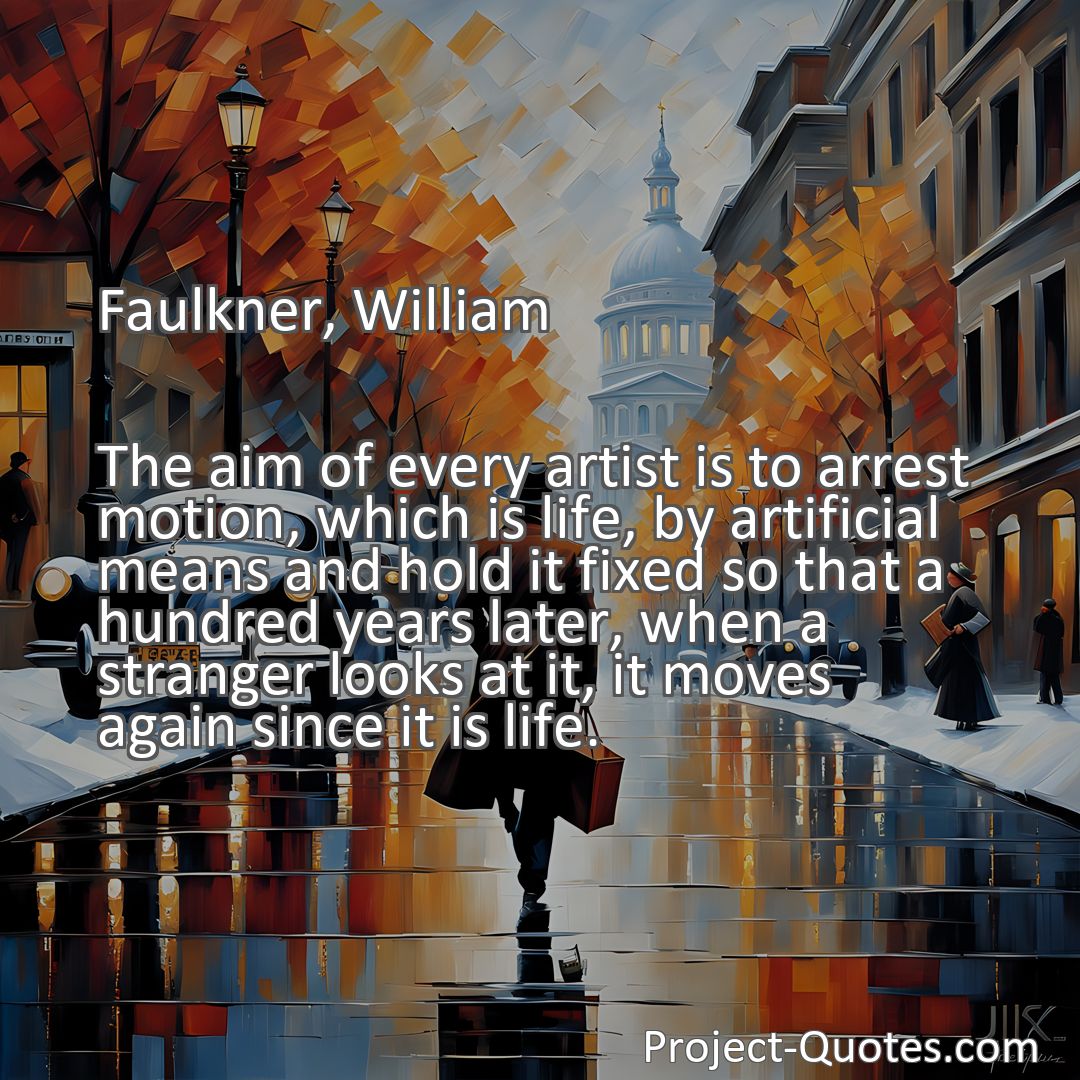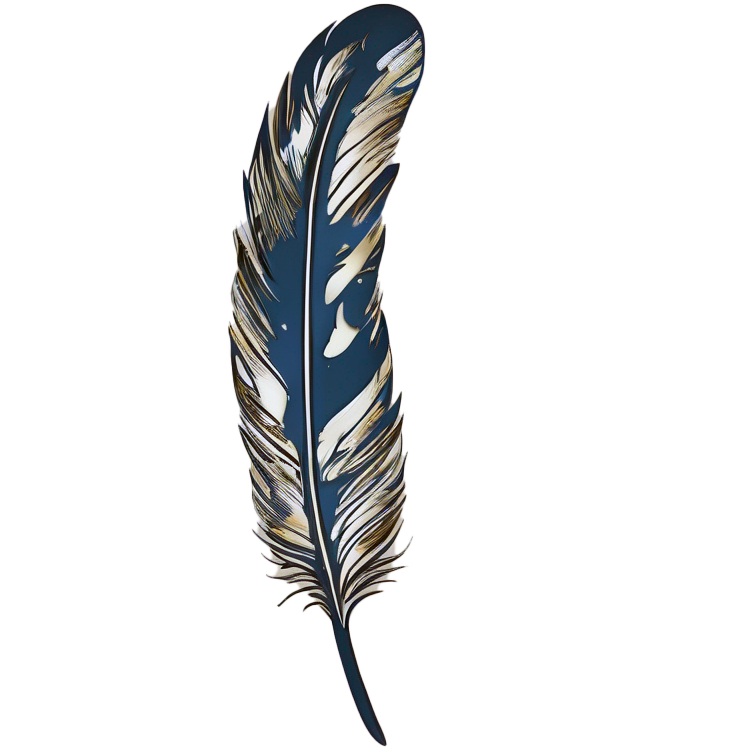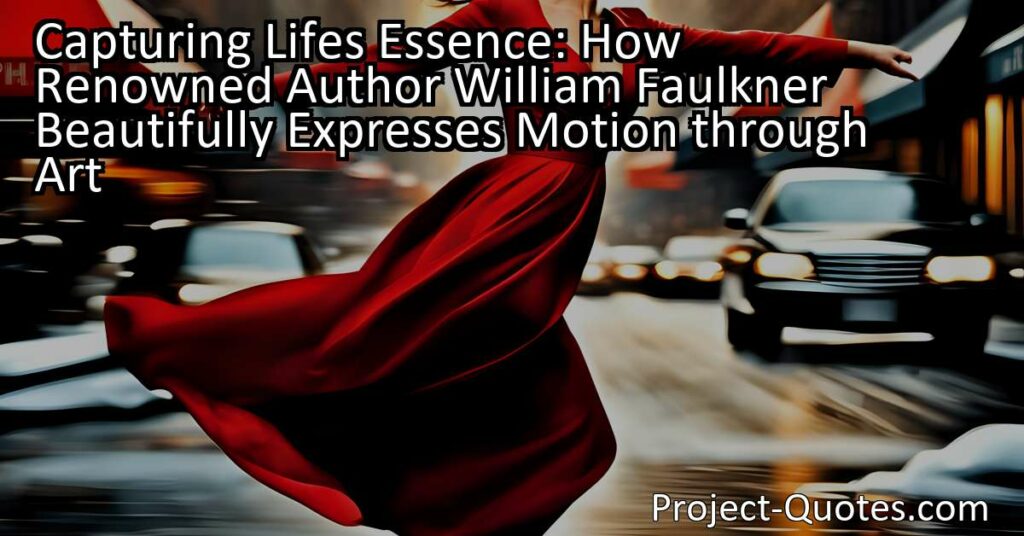The aim of every artist is to arrest motion, which is life, by artificial means and hold it fixed so that a hundred years later, when a stranger looks at it, it moves again since it is life.
Faulkner, William
Renowned author William Faulkner beautifully captures the essence of artistic expression and the power of art to transcend time. Through his profound quote, Faulkner highlights how art can arrest motion and bring it to life, allowing future generations to experience the same emotions and connections. Faulkner’s words remind us of the timeless nature of art and its ability to preserve and express the essence of life.
Table of Contents
- 1 The aim of every artist is to arrest motion, which is life, by artificial means and hold it fixed so that a hundred years later, when a stranger looks at it, it moves again since it is life.
- 2 Faulkner, William
- 3 Meaning of Quote – The aim of every artist is to arrest motion, which is life, by artificial means and hold it fixed so that a hundred years later, when a stranger looks at it, it moves again since it is life.
- 4 Freely Shareable Quote Image
- 5 Related
Meaning of Quote – The aim of every artist is to arrest motion, which is life, by artificial means and hold it fixed so that a hundred years later, when a stranger looks at it, it moves again since it is life.
Capturing Life’s Essence: The Timeless Art of Expressing Motion
Introduction
Art has always been a medium through which humanity seeks to preserve moments, emotions, and stories that define our existence. Renowned author William Faulkner beautifully captures the essence of artistic expression in his quote, “The aim of every artist is to arrest motion, which is life, by artificial means and hold it fixed so that a hundred years later, when a stranger looks at it, it moves again since it is life.” This profound statement encapsulates the purpose and power of art, as well as its ability to transcend time and captivate future generations. In exploring Faulkner’s words, we will delve into the transformative qualities of art that bring life to still images and enable a profound connection between artist and audience.
1. Art as a Timeless Reflection of Life
Art allows us to hold moments in time forever a snapshot of life encapsulated in a painting, sculpture, photograph, or any other artistic medium. Every brushstroke, every line, and every detail reveals the artist’s interpretation of life’s motion. Whether it is a serene landscape, a depiction of human suffering, or an expression of love, art captures the essence of living.
For example, when we gaze at Vincent van Gogh’s “Starry Night,” we become immersed in the swirls of the night sky and feel the vibrant energy that emanates from the canvas. The artist’s use of bold brushstrokes creates a sense of movement, allowing us to experience the pulsating life of the night sky. Through his art, van Gogh shares with us the exact moment he perceived the world around him, inviting future generations to share in that experience.
2. The Role of Art in Conveying Emotion
Emotion is an integral part of the human experience, and art has the incredible power to evoke and express it. Artists utilize their chosen medium to communicate complex feelings, seizing the raw intensity of motion and infusing it into their creations.
When considering the emotional impact of art, we cannot overlook Pablo Picasso’s renowned painting, “Guernica.” Depicting the horrors and devastation of war, Picasso’s use of distorted figures and fragmented shapes masterfully conveys the anguish and chaos experienced during times of conflict. The painting engenders a visceral response in viewers, encapsulating the motion of despair, grief, and outrage within its stillness.
By arresting motion through their unique artistic lens, artists not only express their own emotions but also invite the viewer to experience and engage with their work on a profound level. The artistic process becomes a vehicle for exploring our shared humanity, connecting strangers across time and space.
3. The Evolution of Art Appreciation
As Faulkner suggests in his quote, art possesses the uncanny ability to “move” even after a century has passed. This sentiment highlights the idea that art holds significance beyond the artist’s lifespan, inviting future generations to interpret, appreciate, and find personal connections within the work.
For instance, generations after Leonardo da Vinci, people still flock to view his masterpiece, the “Mona Lisa.” The enigmatic smile of the subject continues to captivate viewers, allowing them to engage with the painting’s subtle motion and to uncover their subjective meanings. Each viewer brings their own experiences and perspectives, breathing new life into the work.
The digital era has significantly expanded the accessibility and relevance of art. Through various online platforms and virtual exhibitions, people from around the world can access art at their fingertips. This democratization of art enables individuals who may not have had the opportunity to visit museums or galleries to develop an appreciation for different periods, styles, and artists. Consequently, art maintains its awe-inspiring ability to touch souls and transcend time, ensuring that even a century later, it continues to move and inspire.
Conclusion
In essence, William Faulkner’s quote aptly summarizes the overarching goal of every artist: to capture life’s motion and hold it tightly within their creations. Art functions as a time capsule, preserving emotions, stories, and moments that would otherwise fade into oblivion. Through artistic expression, we create a profound connection with both our contemporaries and future generations, enabling strangers to experience the same emotions and contemplate the same questions. Thus, the power of art lies not only in arresting motion but also in embracing the eternal vibrancy of life.
I hope this quote inspired image brings you hope and peace. Share it with someone who needs it today!


